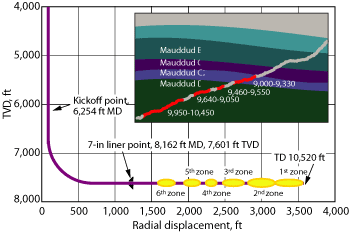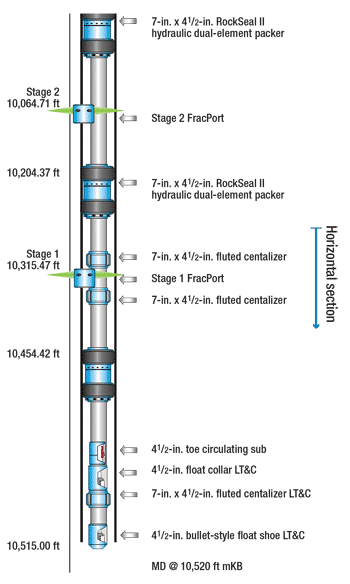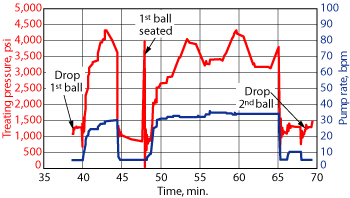COMPLETION/STIMULATION
KOC turns a mutt into a thoroughbred
After watching production in one Sabriyah field well drop to zero shortly after completion, Kuwait Oil Company used new technology to bring it back to life.
Majdi Al-Mutawa, Kuwait Oil Company, and Redha Kelkouli, Schlumberger
An old expression says, “It’s best to let sleeping dogs lie.” Kuwait Oil Company (KOC) could have walked away from its Sabriyah SA210 well and chalked it up to a bad investment, when it stopped flowing shortly after completion in 2004. Instead, the company tried a new technique to rejuvenate the failing well with good results.
The SA210 was an open-hole completion, J-Type directional well. Kick-off point was at 6,264 ft (MD), and the well was landed at 8,376-ft MD (7,621-ft TVD), with a 1,337-ft stepout. A 7-in liner was run and cemented in place at an 8,162-ft MD (7,601-ft TVD). The 2,462-ft production section was drilled with a 6 1/8-in. bit to 10,838 ft (MD). Bottomhole pressure was about 3,093 psi, and temperature was 170°F.
The target formation was the Mauddud Limestone, normally a prolific producer. It was therefore, puzzling to everyone when the SA210 failed to produce. Openhole logs showed effective porosity averaged 20% to 24% across the entire interval. Clay volume was very low, building from almost zero at the heel to about 10% at the toe. Permeability at the formation interface was estimated to range from 5 mD to 20 mD in the lower target zone, but it was believed to range from 10 mD to 50 mD in two of the upper zones. A fourth zone’s permeability ranged to 100 mD. Later, log-derived permeabilities of the reservoir rock indicated an even rosier picture. The tight toe area was calculated to be 46 mD, and the heel zone was predicted to be almost 815 mD. In addition, the entire production zone was split by dozens of longitudinal and transverse natural fractures. So why wouldn’t the well produce?
CHOOSING A FRAC TREATMENT
It was postulated that mud solids and fines from the drilling operation had likely plugged the conductive fractures. Borehole stress plots, made in offset wells, indicated that the maximum horizontal stress was in the NE-SW direction. However, the SA210 wellbore tracked almost due north, right in-between the maximum and minimum field stress concentrations. This meant that a hydraulic fracturing operation could probably open and extend the natural fractures. But if proppant was introduced, premature screen-out was predicted. This is because, as soon as the fracture propagated away from the borehole, it would turn and naturally re-align with the preferred fracture plane, depending upon the field stress pattern. Accordingly, a clean-out-type stimulation was recommended, as opposed to a traditional proppant-type fracturing operation.
Based on the log evaluation, Schlumberger recommended a staged, acid frac treatment to open up and extend the natural fracture system. In many wells, it is possible to bullhead acid treatments to effectively clean up the near-wellbore area. However, in the case of SA210, better results could be achieved by a multi-stage frac job using zonal isolation and chemical diverters to steer the fractures, to maximize reservoir contact. This decision was based on the observed heterogeneity of the Mauddud reservoir. With such a long openhole section, an uncontrolled frac job could go anywhere. The SA210 could easily be converted from a mutt to a “stray dog,” with no improvement in production.
BUILDING A CHAMPION
The Mauddud is stratified into flow units-in the SA210 well, the C2 and D units were selected for stimulation. KOC agreed to run the new StageFRAC* multiple-stage zonal isolation system to ensure proper placement and distribution of the fractures, Fig. 1. This was the first time that the technique was tried in the Middle East. Six candidate stages were selected, based on log evaluation. The new technique allows each zone to be treated individually. Treatment is fast and efficient, with zone-to-zone transition effected by simply dropping a ball. Then, the entire well can be flowed to test its potential. The treatment string is designed to be left in the hole following stimulation as part of the permanent completion. Flow restriction back through the frac ports is negligible and, most importantly, these can be closed later, as needed, for good reservoir management.
 |
Fig. 1. The StageFRAC system improves reliability by placing multiple, individually-isolated fractures in open hole, in one continuous pumping
treatment.
|
|
A dual-acid treatment was proposed. The main treatment fluid was SXE*, which is hydrochloric acid (HCl) with an outer emulsion of diesel for deep penetration. In addition, viscoelastic diverting acid (VDA*) was used to help steer the fluid into unswept areas, to ensure broad distribution of the treatment fluid. VDA has the unique property of effectively stimulating carbonate pay while gelling as the acid spends through reaction with the rock. This progressive gelation diverts acid to untreated zones. During production, the spent acid breaks when it encounters hydrocarbons. VDA gives superior results compared to straight HCl, Fig. 2. Another advantage is that the two proposed fluid systems break each other following the treatment, leading to excellent clean-up and zero formation damage.
 |
Fig. 2. Well trajectory showing the six stage treatment zones in the Mauddud C2 and D reservoirs.
|
|
A total of 1,020 ft was to be treated in six compartments: 9,080-9,200-ft (120 ft), 9,230-9,330-ft (100 ft), 9,460-9550-ft (90 ft), 9,640-9,850-ft (210 ft), 9,950-10,200-ft (250 ft) and 10,200-10450-ft (250 ft), Fig. 3. All fracs are in the Mauddud D zone, except the final stage, which was pumped into the C2 zone. A typical staged sequence consisted of the following steps. After a pre-wash of 15% HCl, 7% VDA was pumped. Bracketed by 15% HCl spacers, the main 28% SXE acid followed. This procedure was repeated once or twice more following another slug of VDA to divert the treatment into previously unswept intervals. Finally a post-treatment flush with 2% KCl was performed. The acid formulation was carefully designed, based on log-derived lithology data and was monitored throughout the job to ensure that it remained stable.
The StageFRAC system used in the SA210 well was comprised of a series of tandem-element, RockSeal II packers, each rated at 10,000 psi differential pressure, that were run-in on 4½-in. pipe. These are designed to run through 7-in. casing and set in open hole. They straddle a ball-actuated, re-closable frac port. To space out the jetting tools precisely, 4½ in. tubing spacers and pup joints were used. Typical stage hardware is shown in Fig. 3.
 |
Fig. 3. Wellbore schematic for the bottom two, treated zones in the SA210 horizontal well section.
|
|
Treatments are punctuated by dropping the balls, and these events can be seen clearly on the stage pressure plots, Fig. 4. When the balls seat, fracture energy shifts abruptly to the next stage. Each stage is pumped until the designed volume of treatment fluid has entered the formation. Formation breakdown can be observed in real time on the pressure curve. The system is very robust.
In the middle of the job, an engine fuel filter clogged, forcing a 21-min. delay until another pump could be brought online. Following the switch, the frac treatment was resumed immediately with no apparent ill effects. All six stages achieved treatment pressures of at least 3,700 psi, with Stage 3 reaching 4,647 psi. In all, 3,310 bbl of slurry was pumped, along with 139,022 gal of clean fluid. The entire job took 182.7 min. to complete. Average injection rate was 21.1 bbl/min., Fig. 4.
 |
Fig. 4. Pressure-time plot showing pressure response of the first stage ball-sealer.
|
|
MAKING CONTACT
Different pressure responses for each stage are clear indicators that a new formation interval was opened each time. Immediately following the last stage, the well was opened to flow back through a 32/64-in. choke. Two hours after clean-up commenced, 100% crude oil was observed at surface. As soon as the well cleaned up, it was tested, using different choke
sizes, and evaluated using nodal analysis. A stabilized production rate of 9,477 bopd was observed on a 96/64-in. choke. This rate is more than three times that of the previous top producing wells in Sabriyah field. A new champion was named-SA 210. 
*Mark of Schlumberger
|
THE AUTHORS
|
|
Majdi Al-Mutawa works in the Field Development Group (North Kuwait) at Kuwait Oil Company. In 1999, he earned a BS degree in petroleum engineering from Kuwait University. After that, he went to work for Kuwait Oil Company as a petroleum engineer. In 2005, Mr. Al-Mutawa was promoted to the position of lead engineer. He has eight years of experience in various petroleum engineering roles.
|
 |
Redha Kelkouli is the Schlumberger Well Services Technical and Sales manager for Kuwait. He joined Schlumberger in 2001 as a field engineer in Aberdeen, Scotland. Mr. Kelkouli holds a bachelor’s degree in civil engineering from the Université des Sciences et de la Technologie Houari Boumediène, Algeria. He is a member of SPE.
|
|








